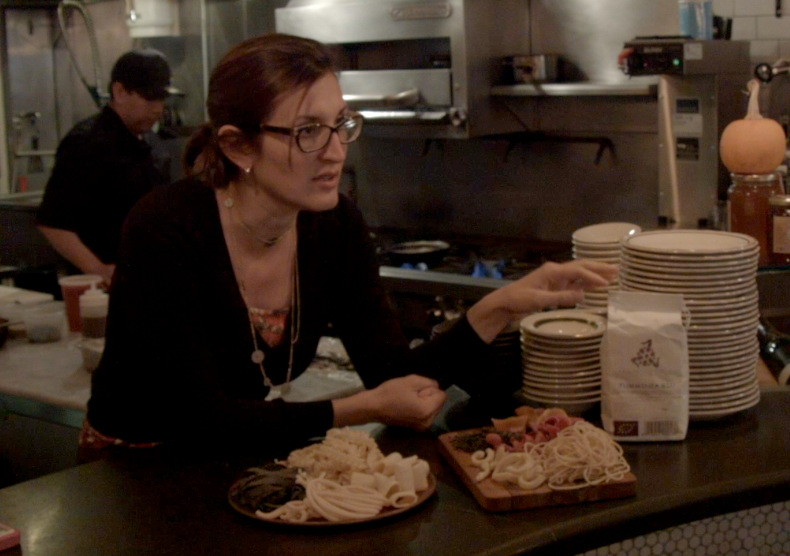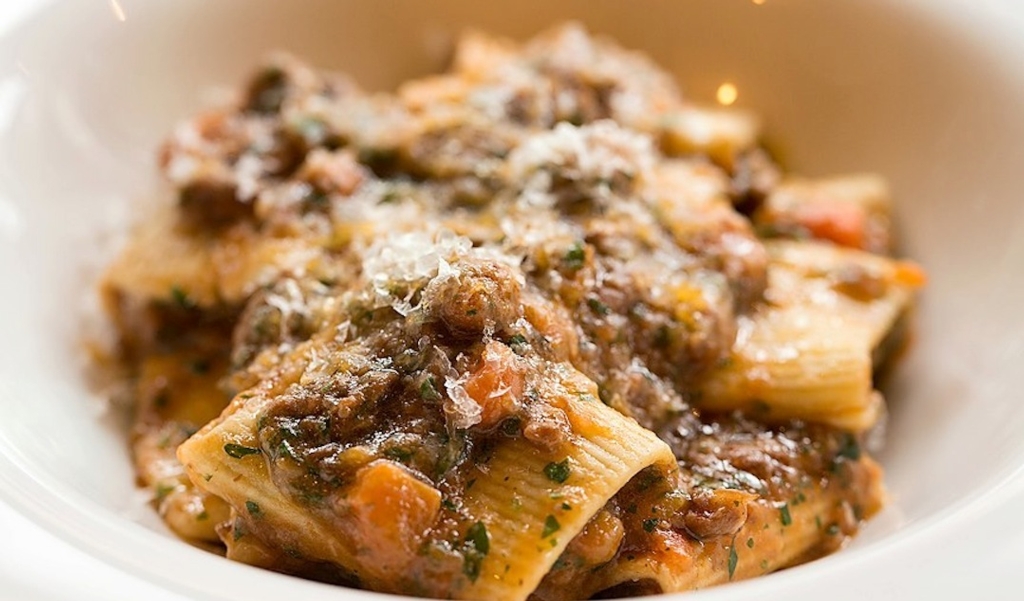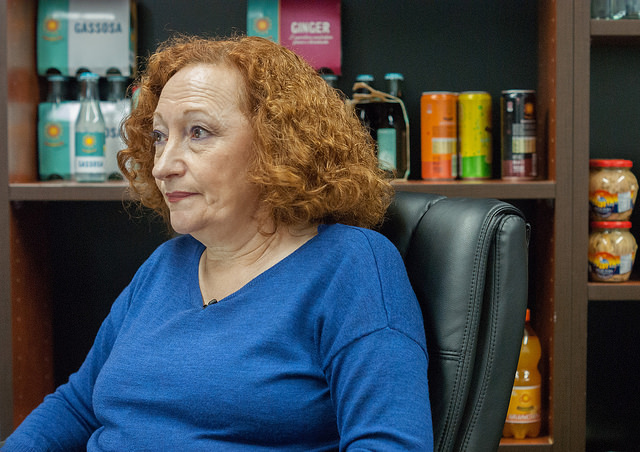How does Italian food here in the U.S. have such an authentic flavor? What makes it possible for dishes in Italian restaurants, especially in New York and New Jersey, to have flavors that make Americans appreciate genuine Italian cuisine?
In order to understand how Italian food is impacting Americans, students of the Business Italian course at Montclair State University interviewed two women who have built their careers around Italian food: one through a restaurant and the other through importing and distribution. Melissa Daka, owner of restaurants Pastai and Eolo in New York, and Sabbia Auriti, COO of Gruppo Fooding and the N Beverage Group in New Jersey, showed us how one can make a difference through authentic Italian products.
Let’s Do the Numbers
The food service industry is not only an important business sector but also a cultural element that defines our society. Thanks to a large population of Italian Americans in the Tri-State Area, the selection of Italian restaurants and products here is very wide, and reflects the regional differences typical of Italian cuisine, which is evident in the Sicilian dishes offered at Daka’s restaurant Eolo.
According to data provided by the Italian Trade Commission, Italy is the 8th largest exporter of agricultural products to the United States. In 2013, the United States imported $4.03 billion in Italian food and wine products, which represented 3.23% of total imports. Italy is the main exporter of wine to the United States; they make up 31.04% of total wine exports, valued at $1.641 million. After wine, olive oil is the second most imported product from Italy to the U.S.; $545 million worth of product exported by Italy in 2013 accounted for more than 50% of the . total amount of olive oil imported by the U.S.. Italy also plays an important role in the American cheese market and exports even more than France. In 2013, Italy exported $309.08 million, which represented 27% of U.S. total cheese imports. Italy is also the principal exporter of pasta to this country, with a 30.65% market share for 2013, and is the fourth largest exporter of baked goods and pastries, corresponding to 3.48% of the market. Italy also maintains a place as the second largest exporter of mineral water, second only to France, and makes up 76.31%, or $72.44 million, of boneless prosciutto imports.
We are obviously dealing with a strategic sector in which Italy still has much potential to grow. The trend is positive and the increasing American appreciation of Italian cuisine is making everybody hopeful.
Scents of Sicily in New York – Melissa Daka
Melissa Daka confirms this success: despite her last name, she is an American with Italian roots and a link to her motherland that forms the base of her profession. Hers is a regional cuisine, and she wants Americans to become familiar with Sicilian flavors in order to help eradicate an old-fashioned view of Sicilian culture.

During the interview, Melissa Daka, chef and owner of the New York restaurants Pastai and Eolo, shows the different types of pasta she uses for her dishes.  

Melissa Daka welcomed us in the back room of her Pastai Restaurant, whose walls are decorated with photos of her ancestors who arrived from Sicily in the first half of the 1900s. 
Her first memories of food are connected to her nonna who had preserved her Sicilian traditions in her own home, after arriving in the U.S. as a child with her own mother who reconnected with her husband, the owner of a café in Little Italy. But perhaps Melissa would not have been so enchanted had she herself not breathed the air of Sicily. “I used to go to Sicily every summer with my parents,” she said as she welcomed us into the back room of Pastai. “The first time we went, I was only two years old and it was also my mother’s first time. She was convinced that Sicily was just like our neighborhood in Queens, just a little bit more rural. In her plans, this would be the trip of a lifetime, mostly to experience the place her mother came from; but she quickly fell in love with the town, the island, the people and the warmth she felt from the family. She wasn’t expecting it.”
It was in Sicily that Melissa developed her passion for Mediterranean food and learned to cook: “In Sicily, I saw things that I never saw growing up here: pizzas made in wood-fired ovens in the countryside; the bonfire during the Feast of the Assumption; the family tradition of coming together to make tomato sauce in front of the house. These are the things that ignited my curiosity in cooking. When I returned, even though I was young, I tried to recreate those smells of our homeland here in the U.S.”
Melissa tries constantly to improve the visibility of Italy in her business, in terms of the quality of food products. And in New York City, thanks to the over-a-century-long presence of Italians who preserve the language and culture, she finds fertile ground. However, Melissa is interested above all in Sicilian cuisine that is not appreciated enough in New York, where Italian restaurants have offered mostly Northern cuisine for many years. For Melissa, it is important that New Yorkers try authentic regional cuisine from the south of Italy and that, through that culinary experience, they learn to look past the stereotypes associated with Sicily. Her objective is to offer a genuine gastronomic experience not only through food, but also through culture, language, and her co-workers.
“My mother believed strongly that we should learn the language,” Melissa recounted. “She grew up speaking the Sicilian dialect with her mother and grandmother, but wished to speak Italian. The first time we went to Italy, before going to Sicily we stopped in Milan, and within five minutes, my mother understood that her language was not Italian. She decided that I needed to speak only in Italian and sent me to learn it so that I would not have the same problems that she had with the old Sicilian dialect that she spoke at home.”

One of the dishes on the menu of Melissa Daka’s Pastai┬áRestaurant.┬á
As Melissa mentioned in the video interview (above), in her opinion, people who work in the Italian restaurant business should know how to speak the language because it creates a better sense of authenticity with the clientele. In this way, Italians who work in the sector are more likely to understand the product, the culture, and the mentality behind it, and help familiarize American consumers with perhaps less popular or more exotic dishes. Melissa’s main goal is to allow Americans to experience Italian food beyond the stereotypes, through ingredients and traditional recipes that are not well known in the U.S. Melissa wants her restaurants to represent an authentic Italy that could become as well known and well liked as other things that Americans consider “Italian,” such as pizza or pasta. Her restaurants introduce diversity by using food to help to create a new identity for Italians in this country. Melissa aims to represent Italian culture more accurately, through her food and through the ambience of her restaurants, which reproduce the welcoming atmosphere of the “Bel Paese,” Italy.
Exporting Flavors – Sabbia Auriti
Restaurants aren’t the only businesses that use the success of Italian cuisine in the U.S. – imported products also play an important role in private kitchens. Under the guidance of Sabbia Auriti, who arrived in the U.S. from Abruzzo in the ‘70s, Gruppo Fooding and The N Beverage Group provide all the necessary items for American foodies to prepare flavorful Italian dishes. The N Beverage Group is the exclusive vendor of brands like Rocchetta, Uliveto, and Elisir in the U.S.; Gruppo Fooding adds olive oil, pasta, canned tomatoes, and more, to this range of products.

Sabbia Auriti welcomed us at the The N Beverage Group┬áheadquarters in┬áLinden (NJ). Photo: Emilia D’Albero

Sabbia Auriti explains to the students the inner workings of the Linden warehouse 
The objective of these groups that Sabbia operates out from Linden, New Jersey, is to offer quality products to the American market; bring visibility to new brands other than those that are already popular; and to create a relationship with Italy as the country that influences many American consumers. A good example of this influence is water. In 2013, the U.S. imported more than $107 million worth of mineral water. However, when you think of Italian mineral water in the U.S., San Pellegrino immediately comes to mind . In reality, according to Sabbia Auriti, the most popular brand of water in Italy is Rocchetta. For this reason, the entrepreneur’s mission is to create awareness around quality products, educate the public, and teach consumers what it really means for an Italian product to be “of high quality”. As a result, she must also deal with imitation products and teach consumers how to distinguish between authentic made-in-Italy products and products that are simply “Italian-sounding” or “packed in Italy”. Working in this business means creating, recreating, and improving the image of the “Made in Italy,” as Sabbia Auriti explained to us. In this sense, she represents the people who fight every day to preserve the high quality of Italian products and of the Italian way of life.
Sabbia Auriti is a vibrant, profoundly passionate person; from the moment we stepped into her office, we could feel the intensity and the passion that she puts into her work through her words and expressions. While we walked through the warehouse, passing pallets heavy with cases of water, peeled tomatoes, olives, olive oil, and other goods, Sabbia reiterated to us how important passion is in this business in order to overcome the challenges of always learning about and introducing products to a new market. In her eyes, the “food and wine” business would not exist without passion.

Jarrett Strenner, video operator and editor (MSUs tudent majoring in TV production and minoring in Italian), during the shooting. Photo: Emilia D’Albero
The New Jersey entrepreneur also underlined how companies like hers contribute to the Italian economy by buying products and creating jobs: “By importing the product and selling it, we make it possible for Italian companies to produce their products. In a market like this, where the percentages are very low and margins are minimal, the small and medium Italian companies manage to survive and remain in business thanks to exports. We make every effort to support them by extending the payment deadlines and adjusting the amount of the orders. It thus becomes a team effort. We are not solely an importer; we represent these companies in the U.S. So, it is in everyone’s best interest that they work and we sell.”
In a global market in which companies fight to survive, it is important to remember that the relationship between the U.S. and Italy improves both countries’ economies, as well as improving Italy’s image abroad.
Through this journey into the world of Italian food in New York and New Jersey, we as students had the opportunity to witness two different aspects of the business: that of the final dishes served in restaurants, and the “behind-the-scenes” process that allows those dishes to have a genuine Italian flavor. When we went to Pastai, Melissa Daka allowed us to try some of her delicious food. At Sabbia Auriti’s company, we understood the origin of the products that allow dishes like Melissa’s to be possible in the U.S. Both made it clear that it is not always easy to sell these products that many Americans aren’t familiar with or are hesitant to try. However, people like Melissa and Sabbia have opened the door to “Made in Italy” products and are in this way educating first their clientele, and then the world.

The team behind the project Business Italian Style: Enza Antenos-Conforti (Montclair SU), Maurita Cardone (La VOCE), Teresa Fiore (Inserra Chair), Giuseppe Malpasso (ArtMotion), and students Jarrett Strenner and Omar Portilla
This is one of the four-episodes series Business Italian Style, a project by The Inserra Chair in Italian and Italian American Studies(Italian Program at Montclair State University), La VOCE di New York, and ArtMotion, developed within the Business Italian class (ITAL321) taught by Enza Antenos, and a Cooperative Education class (ITAL385) taught by Teresa Fiore. Each of the four parts focuses on a different Made-in-Italy sector encompassing Design, Art, Fashion, and Food. The interviews were designed by the Business Italian students, while the filming and editing was done by Omar Portilla and Jarrett Strenner.
First part: Italy Takes Shape in New York.
Second part: Made in Italy? A Question of Style.
Third part: When Art Speaks Italian.
Translated from the original Italian by Emilia D’Albero.










